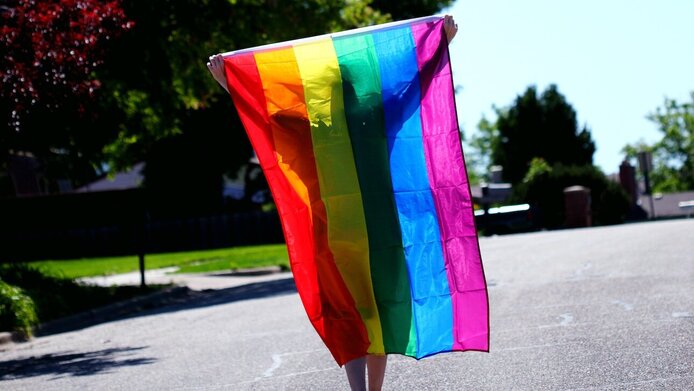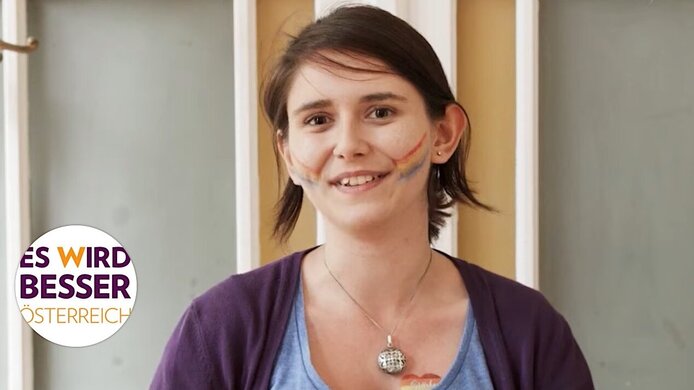Videos as wake-up call for suicidal young people

In his research project Thomas Niederkrotenthaler, head of the Suicide Research & Mental Health Promotion Unit at the Medical University of Vienna, investigates an issue at the intersection of two taboo topics: sexuality and suicide. He does so for good reason: suicide is the second most common cause of death for young people in Austria. On the threshold of adulthood, the time when young people explore and consolidate their (sexual) identity, those who belong to a sexual minority – LGBTQI+ (for lesbian, gay, bisexual, trans, queer, intersex, +) in short – are particularly at risk. This is confirmed by a randomised controlled study funded by the Austrian Science Fund FWF, the results of which are now available: of the young people who participated in the study, 18 per cent stated that they had attempted suicide in the previous year.
When they think that they don’t know anyone who is and feels like them and perhaps even grow up in an unsympathetic environment, young people today can at least look around on the internet, where they may come across the video-based campaign It Gets Better. Designed as a suicide prevention programme, the project was launched in the USA in 2010. An Austrian version began to be developed in 2013. Together with the doctoral student Stefanie Kirchner, Thomas Niederkrotenthaler investigated whether the “It Gets Better” videos could have a preventive effect on their particularly vulnerable target group. While it seemed unlikely at first, the large-scale study brought to light new findings relating to suicide prevention through the media in general.
Robust analysis in three steps
The content analysis of the 192 videos available in the German language revealed that without definite specifications the goal of “suicide prevention in a vulnerable group” can appear random, and not all minority groups can make their voices heard: “In the videos, self-confessed LGBTQI+ adults mostly talk about their coming out and about what preoccupied them before that. It is only rarely that they talk about other stress factors, such as suicidal thoughts or trying to kill themselves. How things got better is something they don’t always elaborate on in concrete terms,” Niederkrotenthaler concludes.
In the second stage of the analysis, LGBTQI+ adolescents discussed the effect of selected videos on themselves in focus groups and tried to assess the effect the videos would have on suicidal peers. In some cases, their recommendations for improved video design were confirmed verbatim by focus groups composed of experts for suicide prevention and media promotion. For the videos to be effective, the viewers would have to be able to identify with the people on the screen. Hence, it is necessary for members of all minorities to be featured and to tell their personal stories – stories that should not be too positive but not scary either. In addition, the videos might include references to professional support services.
For years, the media have been called upon to report on suicide judiciously and avoid sensationalism. In 2010, Thomas Niederkrotenthaler and his team named the preventive effect “Papageno effect”. The name is derived from the bird catcher Papageno, a main character of the opera The Magic Flute, who is about to hang himself because he thinks he has lost his beloved Papagena. At the last second, three boys come rushing in with magic bells and urge him not to throw his life away. “The media are very relevant especially for LGBTIQ+ young people in their coming-out, i.e. the phase when they make their sexual identity public and commit to it. A suitable video featuring an individual they can identify with could well have the function of such magic bells,” Thomas Niederkrotenthaler emphasises.
A surprising indirect effect
The online survey now conducted at three points in time included 516 young respondents, recruited through associations and counselling centres. For the controlled randomised study, the test group was shown the original “It Gets Better” video with a male or female protagonist (Rudi or Alice). The control group saw a separately produced video in which Rudi or Alice spoke in neutral terms about a healthy lifestyle (nutrition, sport, etc.). At the Centre for Public Health, this was the first time that input was tested for its suicide prevention effect even though it did not mention suicidality in detail. The questionnaires were specifically designed to measure how helpful the videos are. Parameters queried included suicidality, self-acceptance, depressiveness, homophobia in the respondents’ environment, the status-quo of their own coming-out, or the definition of sexual identity. The vulnerable young people responded to the questions immediately after watching the videos and again four weeks later.
A small significant effect in the sense of a reduction in suicidality as compared to the control group was revealed immediately after the young people had watched the original video. The parameter of “self-acceptance” was assessed more positively. The factor that was decisive for a decrease in suicide risk was the degree to which the respondents could identify with the person shown or the story told. This, therefore, is the new finding for suicide prevention mediated by the media: the target group that can identify with the media content to a higher degree benefits more from media inputs in terms of reducing suicidality. Moreover, narratives that are more generally addressing the issue of how to cope with crises in life can also reduce suicidality. The preventive effect is probably in essence a consequence of experiencing the narratives of other LGBTIQ+ persons and not only linked to suicide being addressed. “In a follow-up study, we want to investigate to what extent the effect differs between the narrative that is widespread at present, showing the suffering, suicidal person, and narratives that put a greater emphasis on resilience, conveying a message such as 'I'm ok, I can cope and so can you',” explains Thomas Niederkrotenthaler.
Personal details
Thomas Niederkrotenthaler is Deputy Head of the Department of Social and Preventive Medicine and Head of the Suicide Research & Mental Health Promotion Unit at the Centre for Public Health, Medical University of Vienna. His research relates to mental health with a focus on epidemiology and the impact of media on suicide prevention. He is Vice-President of the International Association for Suicide Prevention and Chairman of the Vienna Workshop for Suicide Research. Designed to run until the end of 2021, the project “Effects of 'It Gets Better' Suicide Prevention Videos for LGBQ adolescents” has been funded by the Austrian Science Fund FWF with EUR 140,000.
Prevention campaign: https://itgetsbetter.org/
Publications
Kirchner, S., Till, B., Plöderl, M. et al.: Perceptions of LGBQ+ youth and experts of suicide prevention video messages targeting LGBQ+ youth: qualitative study, in: BMC Public Health 20, 1845, 2020
Kirchner, S., Till, B., Plöderl, M., & Niederkrotenthaler, T.: It Gets Better Videos for Suicide Prevention in LGBTIQ+ Adolescents: Content Analysis of German-Language Videos, in: Crisis: The Journal of Crisis Intervention and Suicide Prevention, 2020






